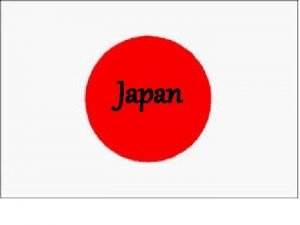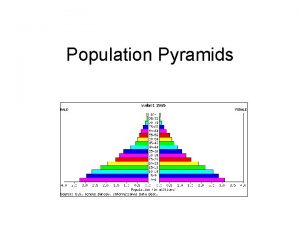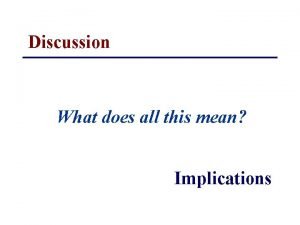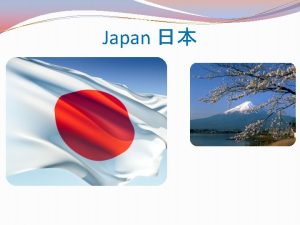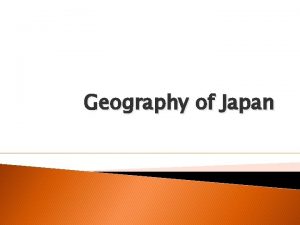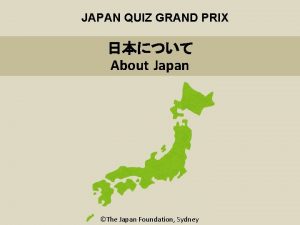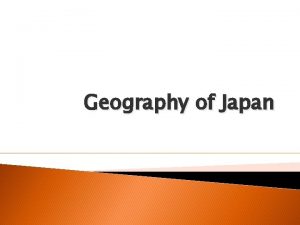Implications Of Population Change in Japan Population Change
















- Slides: 16

Implications Of Population Change in Japan

Population Change • Currently the Japanese population is 126, 323, 715. However in 1955 it was 88, 389, 994 and it is predicted that by 2050 the population will be 107, 411, 392. • Their fertility rate has fallen from 3 in 1955 to 1. 4 in 2016 and fell below replacement level in the 1970 s. • There is -0. 2% annual change in their population demographics and as a result there is significant projected decrease over the next 50 years.


Ageing Population • In Japan there is a huge ageing population with 33% of the population being over 60 (2014 data) • The ageing Japanese society is as a result of increased life expectancy of 85, good healthcare, high standard of living, temperate climate and a low fat diet.



Why has population declined? • In 2004, 99% of the population in Japan were Japanese and there was a net migration rate of 0 per 1, 000 according to the CIA which suggests migration has not impacted population structure. • Emancipation of women means that they are having fewer children at a later age and are focusing on work rather than having a family. • Decreased fertility rate of 1. 4 which is significantly below replacement. • Healthcare is free for under 3 s in most areas however after this there is a cost. It is estimated to cost 4. 4 million yen (£ 27456) to raise a child to age 6.

Social Implications • By 2030 demographers predict that there will be just 2 workers for each retiree, this will pose many problems as it will be hard for the government to afford pensions. In the last few decades, Japan’s social security budget has soared 15 percent, an increase of 1 trillion yen per year. • The Japanese countryside is suffering most as many young people emigrate to urban areas. So in rural areas 2/5 residents are over 65, that’s 40% of the population. • In 2014, the aged dependency ratio was 40%. This is expected to increase to 60% by 2036 and to nearly 80% by 2060. • In 2015, 177, 600 people between the ages of 15 and 29 were caring directly for an older family member. However, the migration of young people into Japan's major cities, the entrance of women into the workforce, and the increasing cost of care for both young and old dependents have required new solutions, including nursing homes, adult daycare centers, and home health programs. Every year Japan closes 400 primary and secondary schools, converting some of them to care centers for the elderly

Economic Implications • • Wealth will decline for Japanese households which by 2024 will be no wealthier than they were in 1997. With a decline of those of working age, there are fewer taxpayers therefore the government gets less revenue There is likely to be a labour shortage especially in farming, factory and construction industries. Healthcare and nursing home costs in 2025 are expected to be almost one trillion dollars, about 12% of GDP. The U. S. Census Bureau estimated in 2002 that Japan would experience an 18% decrease in its workforce and 8% decrease in its consumer population by 2030, but the Japanese labour market is already under pressure to meet demands for workers, with 125 jobs for every 100 job seekers at the end of 2015, as older generations retire and younger ones shrink. Mounting labor shortages in the 1980 s and 90 s led many Japanese companies to increase the mandatory retirement age from 55 to 60 or 65. The average farmer in Japan is 70 -years-old.

Political Implications • The Greater Tokyo Area is virtually the only locality in Japan to see population growth, mostly due to internal migration from other parts of the country. • The increasing proportion of elderly people has a major impact on government spending. As recently as the early-1970 s, the cost of public pensions, health care and welfare services for the aged amounted to only about 6% of Japan's national income. In 1992 that portion of the national budget was 18%, and it is expected that by 2025 28% of national income would be spent on social welfare. Because the incidence of chronic disease increases with age, the health care and pension systems are expected to come under severe strain. In the mid-1980 s the government began to reevaluate the relative burdens of government and the private sector in health care and pensions, and it established policies to control government costs in these programs.

Environmental Implications • As young people move away from rural areas and the population there declines, businesses close down which means people often need to drive further to reach stores, schools and hospitals, causing more carbon dioxide emissions. • There is higher per capita home energy use because there are smaller households with only one or two people.

Management • Consumption taxes doubled from 5% to 10% allowing Japan to fund the increasing pension costs. • The Bandai Toy Company has offered each employee 6, 000 yen for every third and subsequent child born to a couple. • Review of strict immigration laws to allow in some workers, especially from the Philippines and Indonesia, as care workers and also highly skilled internationals.

• Japan has focused its policies on the work-life balance with the goal of improving the conditions for increasing the birth rate. To address these challenges, Japan passed the Child Care and Family Care Leave Law, which took effect in June 2010. • The law provides fathers with an opportunity to take up to eight weeks of leave after the birth of a child and allows employees with preschool-age children the following allowances: up to five days of leave in the event of a child’s injury or sickness, limits on the amount of overtime in excess of 24 hours per month based on an employee’s request, limits on working late at night based on an employee’s request, and opportunity for shorter working hours and flex time for employees.

• The Child Allowance Scheme has been modified so that parents are given a one-off payment of 5, 000 yen for the first and second child and 10, 000 yen for third and subsequent ones • A policy was introduced in 1992 to allow workers up to one year’s unpaid leave to care for their children. The Angel Plan (1995– 1999) • The main concern of the initial Angel Plan lay with Japan’s working mothers. It set numerical targets to increase the number of; child-care facilities (from 2230 to 7000), emergency child-care facilities (from 450 to 3000) and after school clubs (from 4520 to 9000). The New Angel Plan (2000– 2004) • The New Angel Plan (2000– 2004) increased efforts of supporting stay-at-home mothers.

Was Management Sustainable? • The government felt the need to implement these initiatives when the country's fertility rate hit a record low of 1. 57 in 1989. Current trends at that time showed the fertility rate continuing to decrease which would cause social and economic problems in the later future such as a decreasing population as well an aging population, which would mean that the government would need to allocate a lot more money on pensions, nursing homes and other programs to help the elderly. Also if the trend of a decreasing fertility rate continued, the government feared of a serious labour shortage in the future.

• Unfortunately, the Angel Plan was unsuccessful. By comparing today's fertility rate of 1. 23 with the 1989 fertility rate of 1. 57, which initiated the government's concern, it can be seen that the Angel plans have done nothing to slow down Japan's declining birth rate. Overall, the main goal of both Angel Plans was to encourage the Japanese population to have more children. The situation still shows no signs of improving as a government report in 2012 said that by 2060, Japan will have 87 million people, down from today's 128 million and the proportion aged 65 or older is expected to double to 40%. • This proves little or no improvement on the population management- one way to increase workforce and supply for the elderly population would be to change the restrictive laws on migration and allow migrants to provide taxes for the government- however the Japanese are very reluctant to do this.
 Japan population
Japan population Population of japan
Population of japan Constrictive population pyramid
Constrictive population pyramid Japan population 2020
Japan population 2020 Population pyramid vocabulary
Population pyramid vocabulary Nystatin nursing implications
Nystatin nursing implications What are legal implications
What are legal implications Discussion and implications
Discussion and implications Mathmatical proposition
Mathmatical proposition Educational implications of learning curve
Educational implications of learning curve Constructivism
Constructivism Cengage learning
Cengage learning Legal dimensions of nursing practice
Legal dimensions of nursing practice Ranexa nursing implications
Ranexa nursing implications Implications of nativist theory
Implications of nativist theory Eng2d media unit
Eng2d media unit Educational implications of existentialism
Educational implications of existentialism

